I finally made the bread of my dreams, a baking goal I’ve been chasing ever since grade school: the softest, fluffiest white bread!
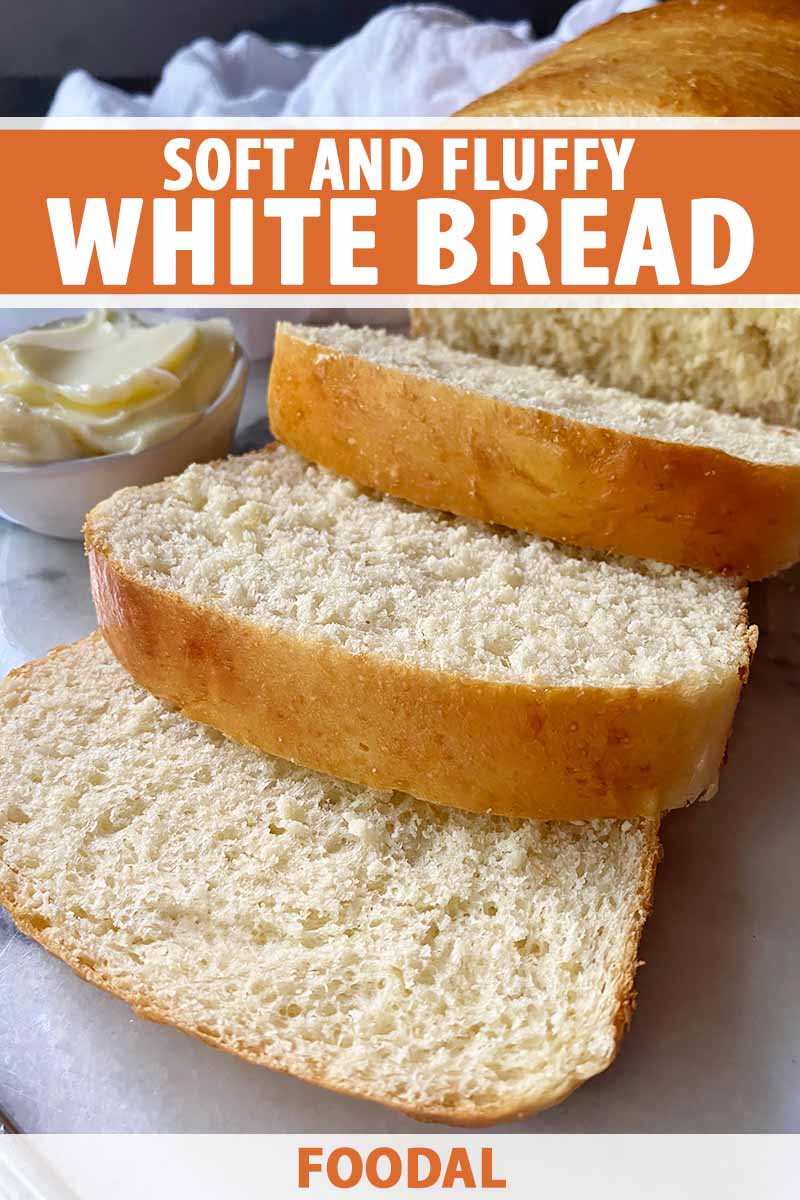
We all have our picky tendencies as kids, some more severe than others.
Unlike my younger brother, who refused to eat anything except plain pasta, chicken nuggets from McDonald’s, and Cinnamon Toast Crunch cereal, I’ve always been pretty open and inquisitive with food choices.
Except when it came to bread. I never really cared for sourdough, whole wheat, or anything enriched with nuts or dried fruits.
And the crusts were never something I particularly enjoyed, either.
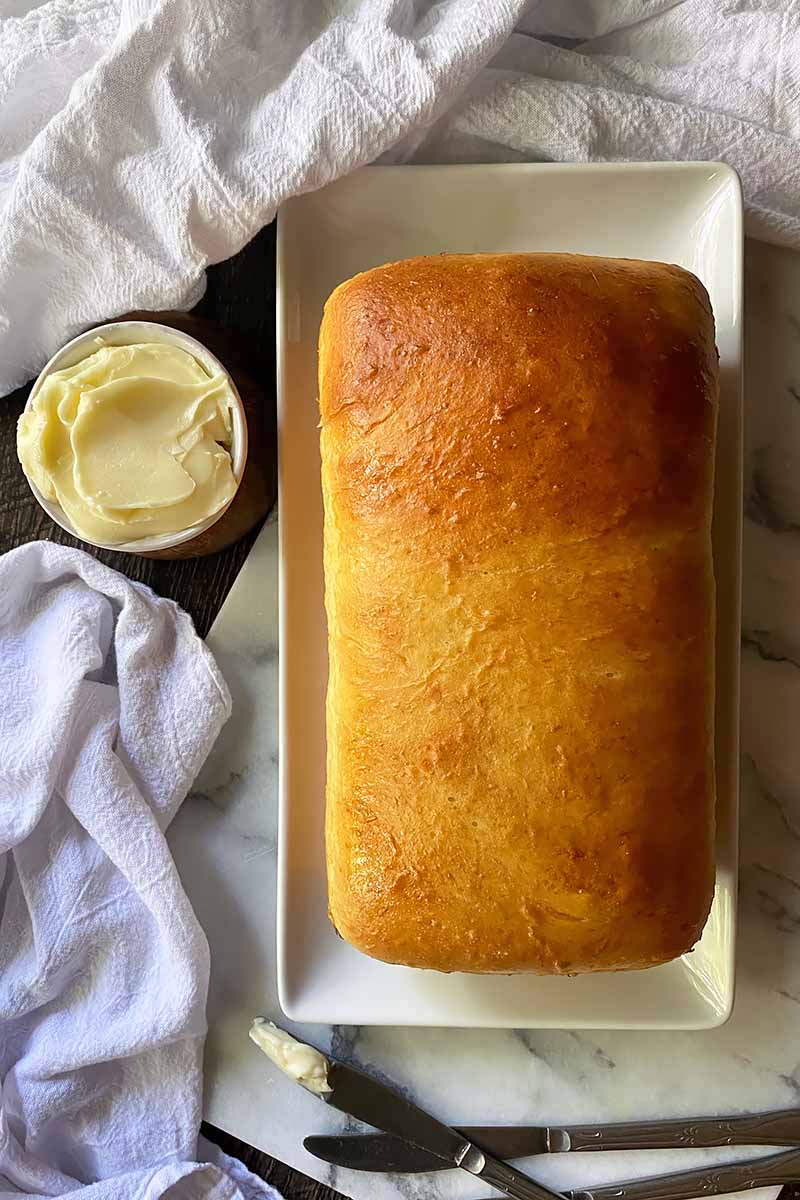
I would always have a routine when eating a slice from a loaf I didn’t really like: slowly nibble and pick away from the center outwards, getting as close to the crust as possible, crumb by crumb. The crust was always left behind – tormented, deformed, and alone.
It was a hideous process, but I thought it was completely necessary.
The one exception to my garish procedure was soft and fluffy white bread. I loved that kind.
Remember those big fat rolls you would get for school lunches? Glistening with butter? I could devour one in mere seconds, the whole thing, even the crust!
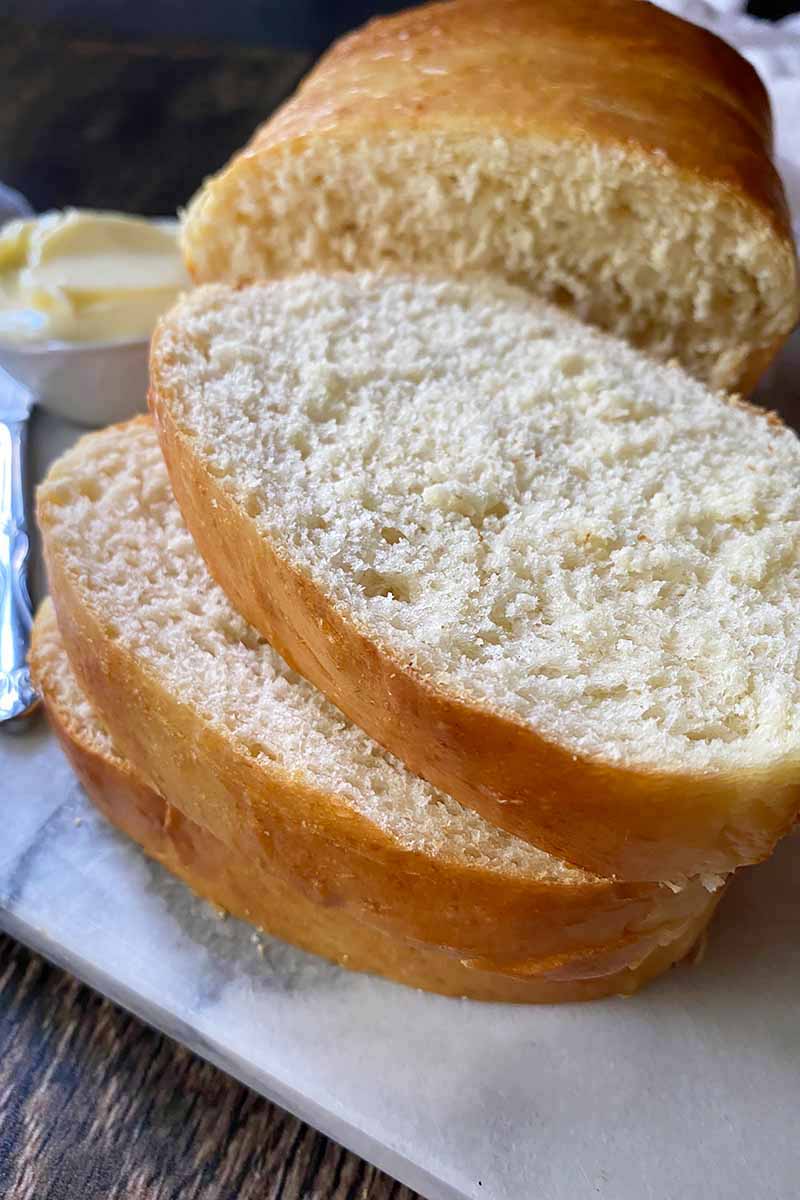
The crust was just as soft and luscious as the delightfully doughy, but not underbaked, interior.
Happily, those rolls followed me throughout all the years of my elementary, middle, and high school education.
But sadly, my daily intake of that perfect serving of carbohydrates halted once I graduated.
If I close my eyes now, I can still recall the aroma of warm, sweet sugar and yeast wafting through the corridors of the school buildings, completely overpowering the smell of chalk, pencil shavings, and chlorine from the high school pool – enticing me, beckoning me to the lunchroom…
Ever since graduation, after shifting that tassel from one side of my cap to the other, I made a personal oath to find a way to bake that bread, to bake a loaf that was just as soft and fluffy as what I ate nearly every day for years of my childhood.
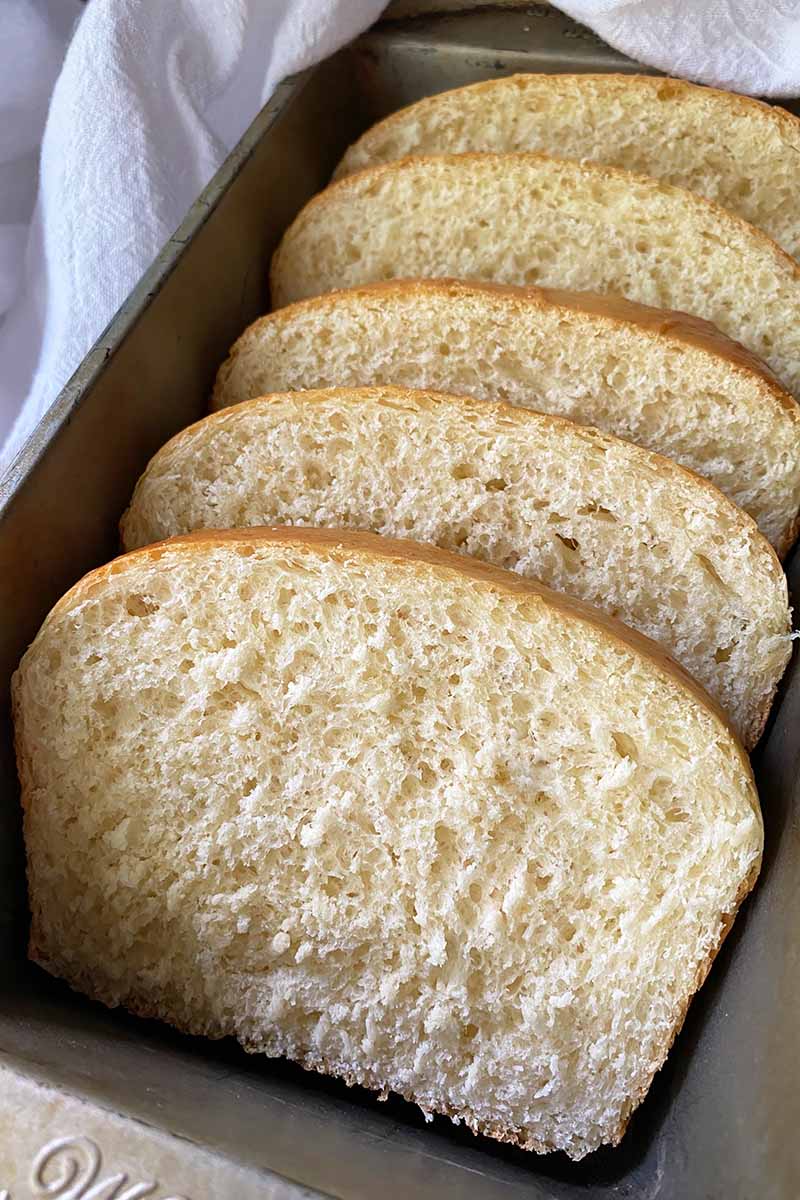
How did those lunch ladies do it? Even my mom was a lunch lady for a year or two, but she was never responsible for making the recipe. Sure, she made the meatloaf mix all the time, but never the rolls.
Not. Fair.
So I went through the entirety of baking and pastry school and multiple bread baking jobs making similar recipes, and I was still unsatisfied.
Until now. I finally did it!
It took well over 10 years, but I cracked the code on how to make old-fashioned white bread. And I am here now, proud and triumphant, to share this recipe with you.
It’s far easier than what you would expect, nothing farfetched outside the realm of basic bread baking. The recipe is simple to follow, and you’ll have a beautiful loaf in a handful of hours.
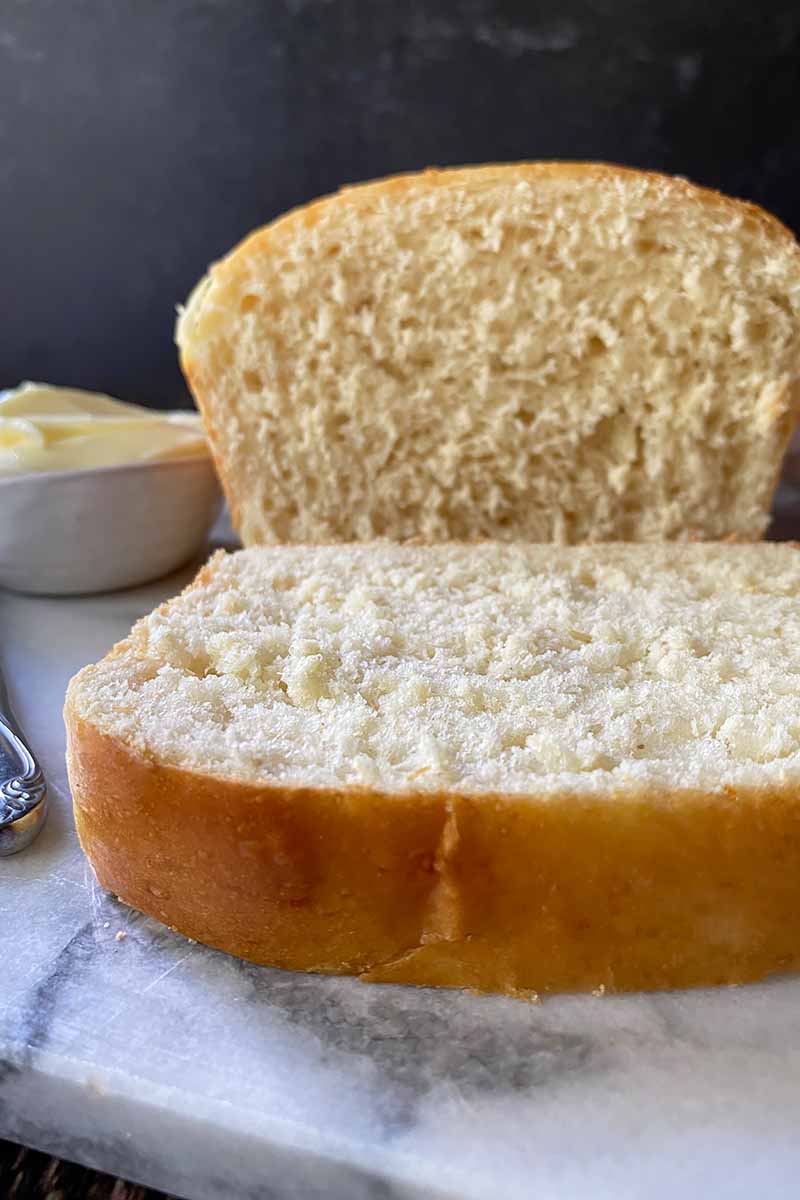
A soft and fluffy style of bread heavily relies on the high fat and protein content of milk, which is why there is a mixture of whole milk, heavy cream, and dry milk powder used here.
And you must not rush the fermentation process – the height and fluffy texture you want requires thorough gas development in the gluten network, so you need to let the dough rise for the appropriate amount of time.
Trust me. I waited over 10 years until I finally made my perfect version. I know you can wait a few hours!
Print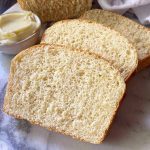
Soft and Fluffy Old-Fashioned White Bread
- Total Time: 3 hours, 30 minutes
- Yield: One loaf (6-8 servings)
Description
Learn how to make beautifully soft and fluffy white bread. It will be a favorite in your household for sandwiches, toast, and more.
Ingredients
For the Bread:
- 2/3 cup whole milk
- 1/3 cup heavy whipping cream
- 1/4 cup granulated sugar
- 1 tablespoon active dry yeast
- 2 1/4 cups bread flour, plus 1/4 cup as needed
- 2 tablespoons nonfat dry milk powder
- 1 1/2 teaspoons salt
- 1 large egg, room temperature
- Vegetable oil, for greasing
For the Crust:
- 1 large egg
- 1 tablespoon water
- 2 tablespoons unsalted butter, melted
Instructions
- Combine the milk and cream in a small saucepan. Heat on low until the temperature reaches 100-110°F, about 3 to 5 minutes.
- Remove from the heat and transfer to a medium-sized heatproof bowl. Whisk in the sugar and yeast. Let stand for 10 minutes, or until the yeast is activated and the mixture becomes very foamy.
- In the bowl of a stand mixer, whisk together by hand the 2 1/4 cups flour, dry milk powder, and salt. Attach the bowl to the stand mixer fitted with the dough hook attachment. Add the egg and milk/yeast mixture. Knead on medium speed for 10 to 15 minutes, until a thick and slightly sticky dough forms. If the dough seems too wet, slowly add the remaining 1/4 cup flour.
- Transfer the dough to a large bowl coated in a film of vegetable oil, rolling the dough in the bowl to coat the exterior. Tightly cover the bowl with plastic wrap and let stand at room temperature for 1 1/2 to 2 hours, or until the dough has doubled in size. Remove the plastic, punch down the dough, and cover the bowl with plastic wrap again. Let the dough rest for 10 minutes.
- Grease a 9-by-5-inch loaf pan with a thin coating of vegetable oil. Once the dough has rested, transfer to a clean work surface and press into a large, flat oval with your hands.
- With the skinny end of the oval facing you, fold over the top 1/3 of the oval into the center, then the bottom 1/3 into the center over the previously folded dough, like folding a letter. Press down on the seam. Gently fold the dough in half, and gently press down to seal the seam. Gently roll to continue sealing the seam, rolling and stretching out the shape if needed. You want the log to be a little smaller than the dimensions of the pan so that there is room to expand – aim for about 8 inches long and 4 inches wide.
- Place the log inside the prepared loaf pan seam side down. Coat the top of the bread with a thin film of vegetable oil and gently drape plastic wrap over the top. Let stand at room temperature for 1 hour, or until the loaf has risen slightly higher than the top of the pan. As the dough is rising, preheat the oven to 350°F.
- For the egg wash, whisk together the egg and 1 tablespoon water. Once the dough has risen, remove the plastic wrap, and gently brush the top of the loaf with a thin layer of the egg wash.
- Bake the loaf for 20 to 25 minutes. The dough will be puffy and lightly browned on the surface. Remove from the oven, and immediately brush with the melted butter.
- Allow to cool in the pan for 10 minutes before gently removing and transferring to a cooling rack to cool completely.
- Prep Time: 30 minutes
- Cook Time: 30 minutes
- Category: Bread
- Method: Baking
- Cuisine: Baked Goods
Keywords: white bread, old-fashioned
Cooking by the Numbers…
Step 1 – Prep
Measure all of the listed ingredients for the bread dough.
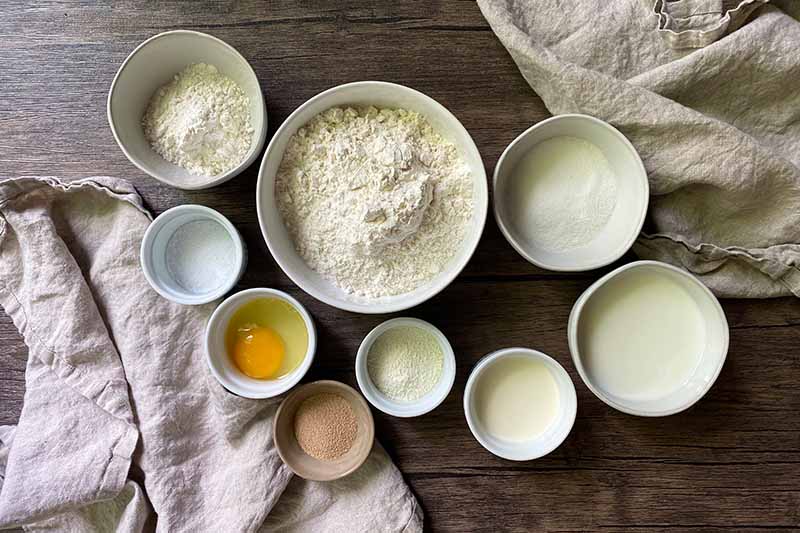
Place the heavy cream and whole milk in a saucepan and heat on the stovetop until a thermometer registers between 100 and 110°F.
This is the preferred temperature range to trigger active dry yeast for the strongest yeast activity. Anything higher than this may potentially kill the yeast.
Step 2 – Activate Yeast
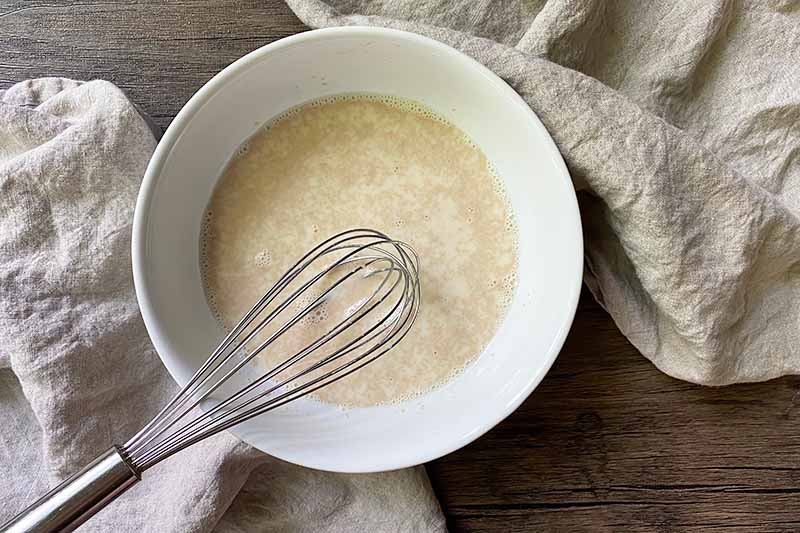
Once the milk and cream reach the right temperature, remove from the stovetop and carefully pour the mixture into a medium-sized heatproof bowl.

Whisk in the sugar and active dry yeast until they completely dissolve. Let stand for about 10 minutes, until the liquid becomes very frothy.
Step 3 – Make Dough
In the bowl of a stand mixer, whisk together the 2 1/4 cups flour, the salt, and the milk powder by hand. Whisking will help to evenly distribute the dry ingredients before adding the liquid ingredients.
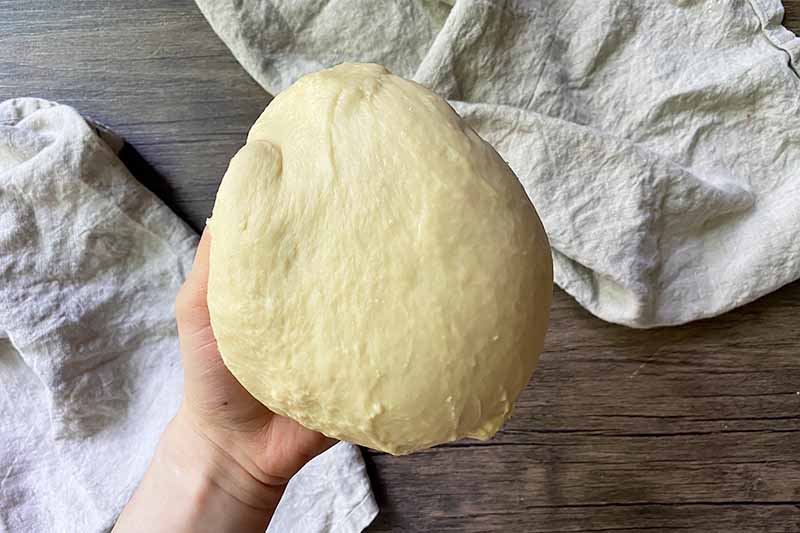
Attach the bowl to the stand mixer fitted with the dough hook attachment. Add the egg and milk/yeast mixture. Knead on medium speed for 10 to 15 minutes, until a thick dough forms.
The dough will be slightly sticky, but if it seems too wet, slowly add in the remaining 1/4 cup flour. You may not need to use all of it.
Step 4 – The First Rise
Transfer the dough to a large bowl coated with a film of vegetable oil. A plastic bench scraper is the perfect tool to help remove the sticky dough from one bowl and transfer it to the other!
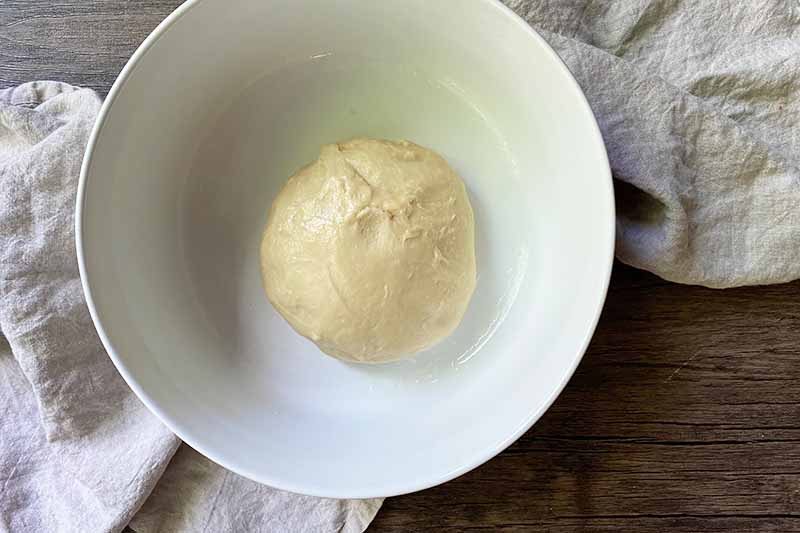
Roll the dough in the oiled bowl to lightly coat the exterior. This keeps the surface of the dough moist, so it doesn’t develop a layer of skin.
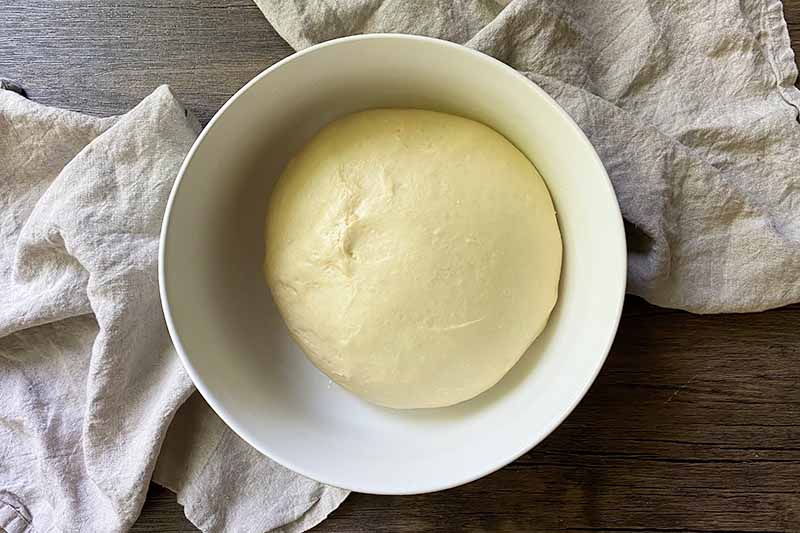
Tightly cover the bowl with plastic wrap and let stand at room temperature for 1 1/2 to 2 hours, or until the dough has doubled in size.
Depending on your home’s temperature and humidity levels, the first rise may take less or more time than the recommended range. Keep an eye on it.
Step 5 – Form into a Loaf
Grease a 9-by-5-inch loaf pan with a thin coating of vegetable oil.
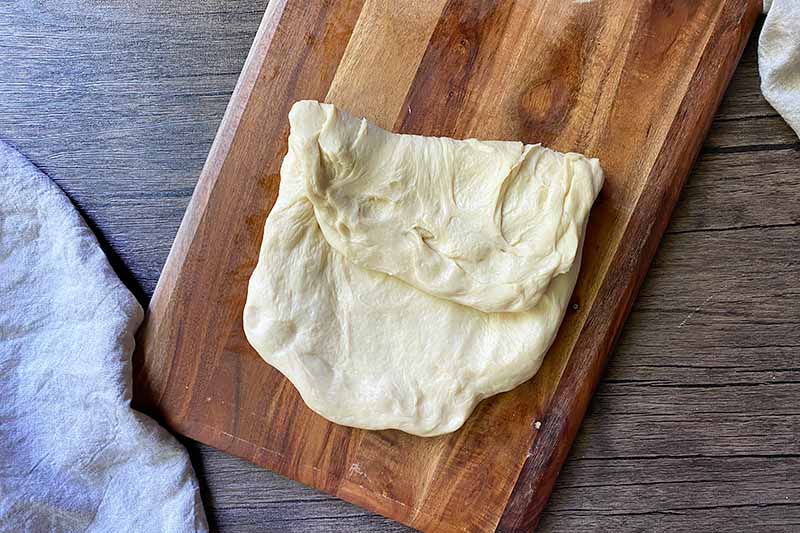
Punch down the dough and let it rest for 10 minutes to redistribute the gluten network.
Once the dough has rested, transfer to a clean work surface and press into a large flat oval.
With the skinny end of the oval facing you, fold over the top third of the oval into the center, then the bottom third into the center over the previously folded dough, like folding a letter. Press down on the seam.
Gently fold the dough in half, and gently press down to seal the seam.
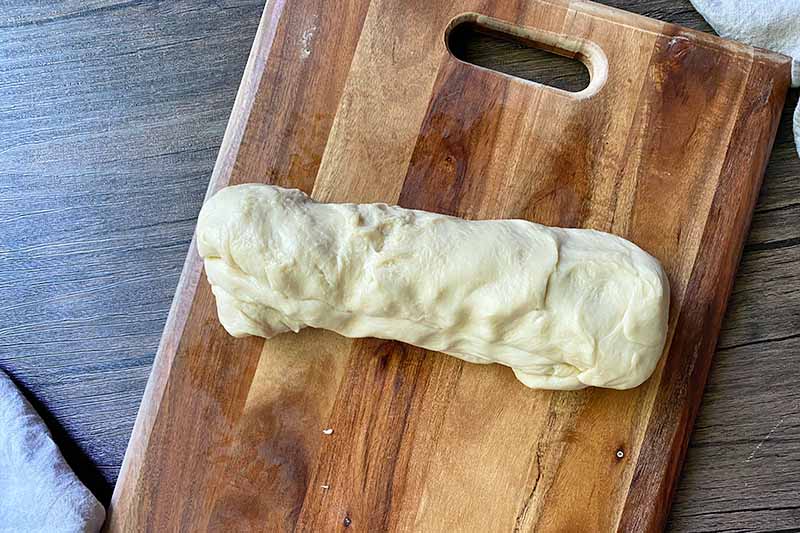
Gently roll to continue sealing the seam, rolling and stretching out the shape if needed. You want the log to be a little smaller than the dimensions of the pan so that there is room to expand – aim for about 8 inches long and 4 inches wide.
Step 6 – The Second Rise
Transfer the log to the prepared pan. Spread a film of vegetable oil on top of the dough, and gently drape plastic wrap over the top. You don’t want to tightly wrap it, to ensure the dough has enough room and space to expand without any limitations.
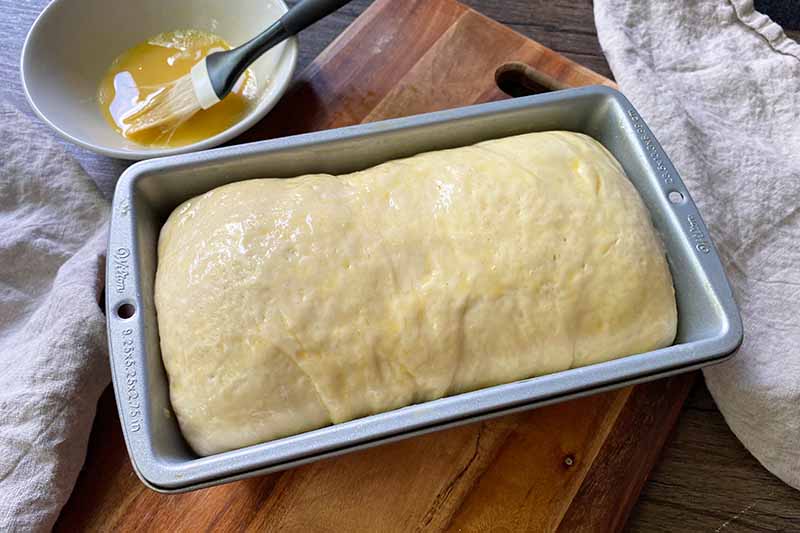
Let stand at room temperature for 1 hour, or until the loaf has risen slightly above the top of the pan.
Like with the first rise, the time required for the dough to double in size will depend on your home’s temperature and humidity level.
As the loaf is rising, preheat the oven to 350°F.
Step 7 – Bake
Whisk together the egg and 1 tablespoon water for the egg wash. Remove the plastic wrap, and gently brush the top of the loaf with a thin layer of the egg wash.
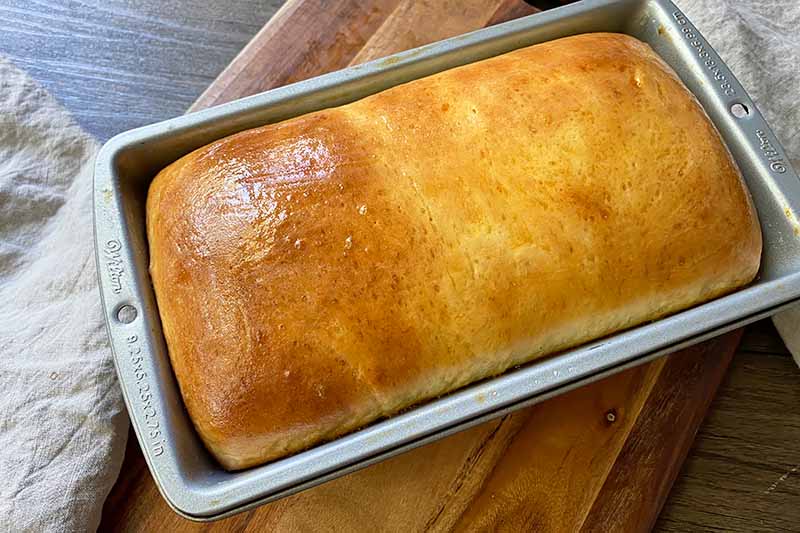
Bake the loaf for 20-25 minutes. It will be puffy and lightly browned on the surface when it’s done. Remove from the oven, and immediately brush with the melted butter.
Allow to cool in the pan for 10 minutes before gently removing and transferring to a cooling rack to cool completely.
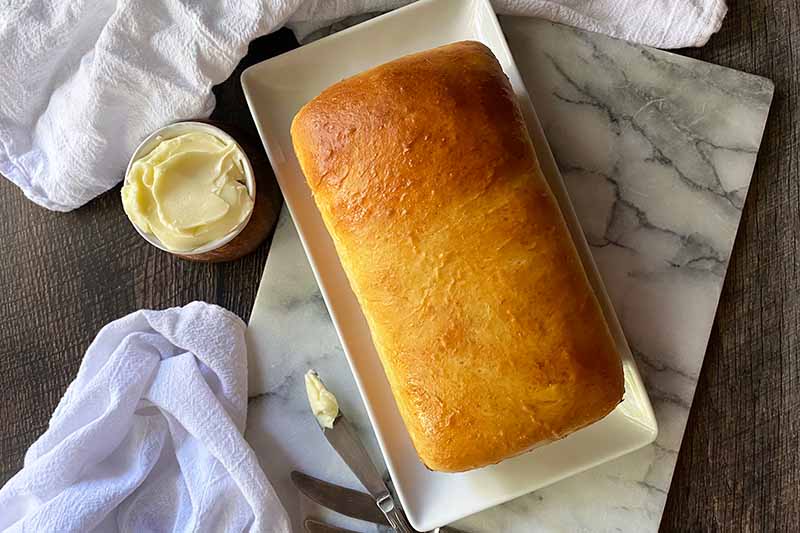
But if you can’t wait, the best slices (in my opinion) are enjoyed when the bread is still warm…
Bake and Enjoy – Quickly!
Look at that beautiful loaf of bread you just baked. Well done!
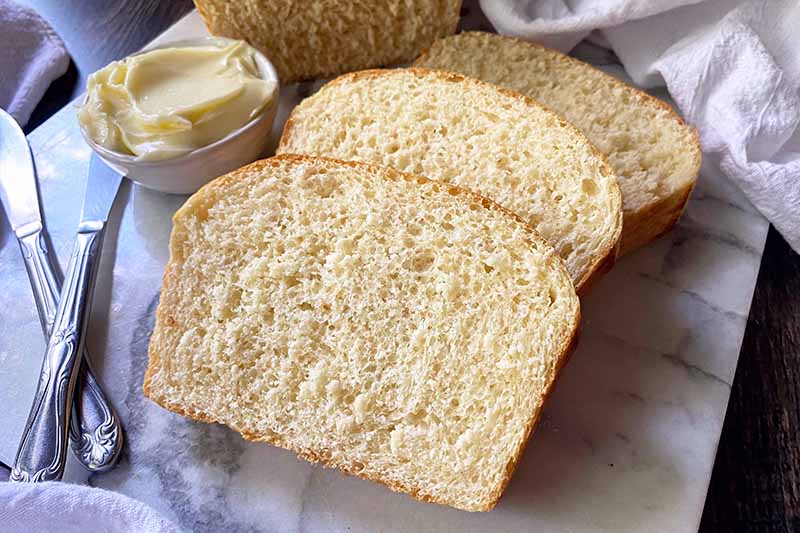
But don’t stare at it for too long – because of its high moisture content, you should consume it within three to five days. Beyond that, you’ll start noticing all the signs of dwindling quality like staleness and mold growth.
My advice is to enjoy it as soon as possible… no complaints here!
We have so many tasty suggestions to make the entire loaf disappear – including the ends! – in just a few meals:
- There’s nothing more effortlessly delicious than starting your morning with toast spread with softened butter and your favorite jam, jelly, or preserves.
- For a summery take on a classic sandwich, make our recipe for peach basil grilled cheese.
- Pulled pork sandwiches anyone? Juicy and succulent classic American pulled pork and some crisp coleslaw or bread and butter zucchini pickles would be amazing piled high on a sandwich.
- You can also choose to freeze the bread once it cools completely, either sliced or as a whole loaf. Once thawed, the bread is fantastic as a base for meatloaf muffins and meatballs.
I could seriously go on and on and on with more recommendations! But I’d love to know how you would enjoy a freshly baked loaf of bread.
Breakfast, lunch, dinner, or a snack – all the meals throughout the entire day will be extra delicious with this recipe. How will you use it? Leave a comment below with your best ideas.
Don’t stop baking with just this one loaf! We have so many more homemade bread recipes for you to try next, starting with these:
Photos by Nikki Cervone, © Ask the Experts, LLC. ALL RIGHTS RESERVED. See our TOS for more details. Originally published by Shanna Mallon on January 7, 2009. Last updated on June 9, 2021.
Nutritional information derived from a database of known generic and branded foods and ingredients and was not compiled by a registered dietitian or submitted for lab testing. It should be viewed as an approximation.
About Nikki Cervone
Nikki Cervone is an ACS Certified Cheese Professional and cheesemonger living in Pittsburgh. Nikki holds an AAS in baking/pastry from Westmoreland County Community College, a BA in Communications from Duquesne University, and an MLA in Gastronomy from Boston University. When she's not nibbling on her favorite cheeses or testing a batch of cupcakes, Nikki enjoys a healthy dose of yoga, wine, hiking, singing in the shower, and chocolate. Lots of chocolate.

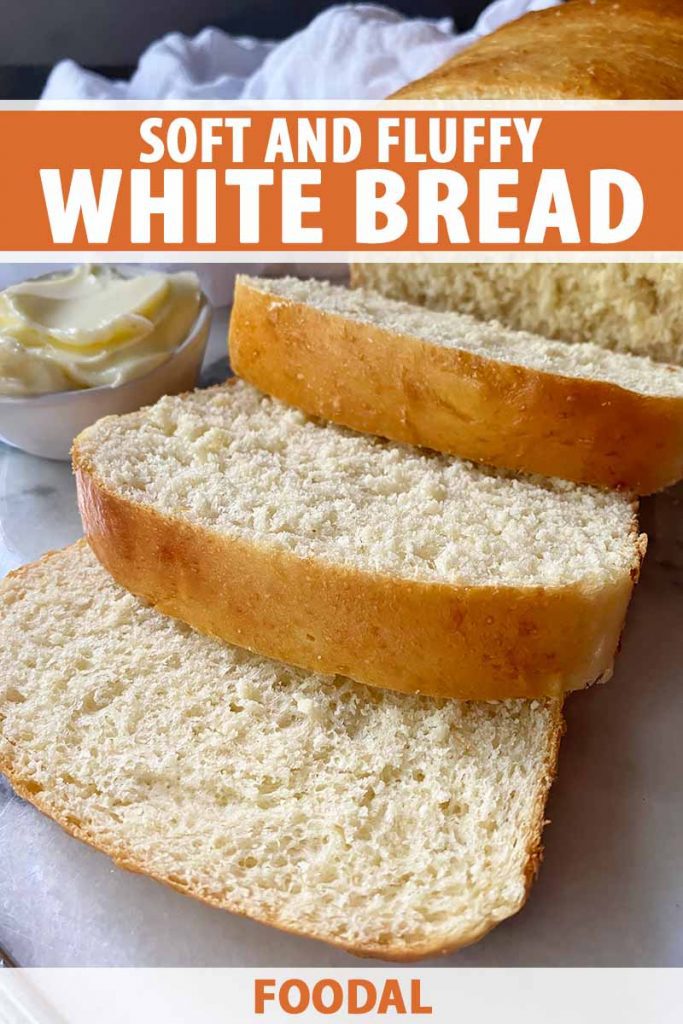

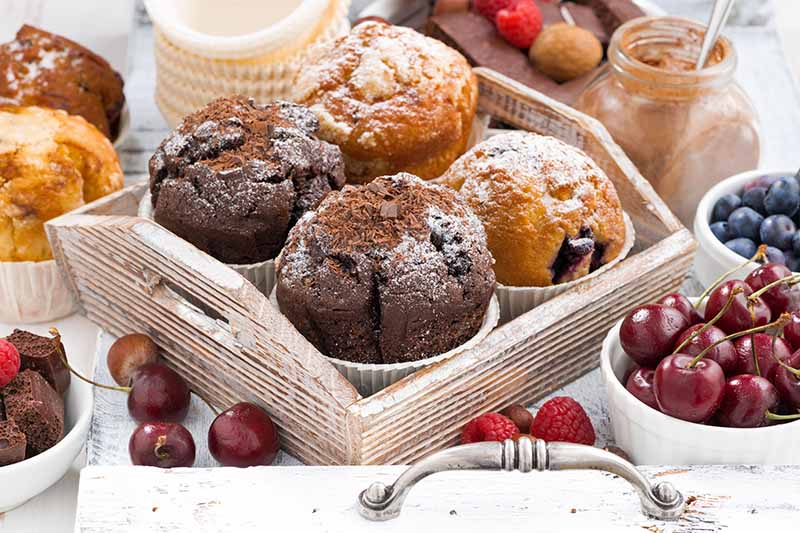
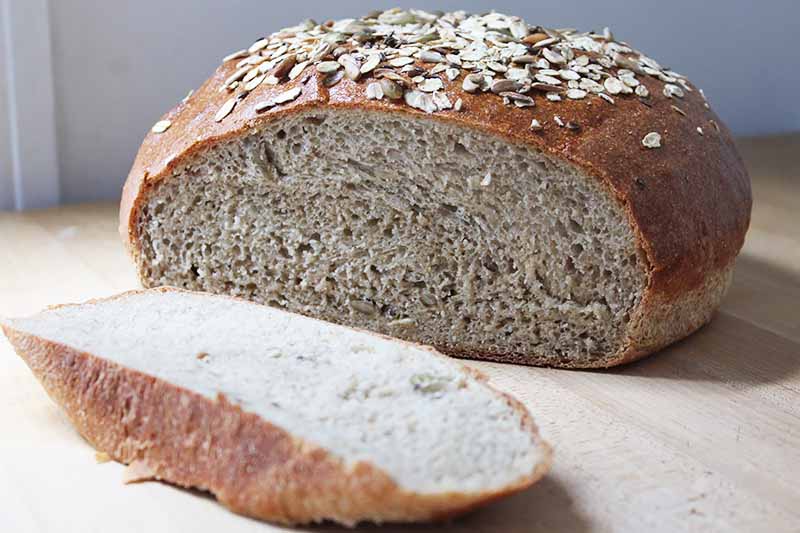
i went thru a bread thing this week too. i was so completely amazed with my stand mixer. one moment it was just doing its thing and another, elastic dough! other than an avocado peeler, stand mixers are the best kitchen inventions ever.
jab asked me why i didn’t have regular sliced bread at home anymore. um. hello? why would i when i can make my own bread. something about the warm, yeasty-ness of homemade bread that makes store-bought bread pale in comparison. i don’t think i’ll ever buy bread again…
you know me– ive got 4-6 loaves baking a week. i love it!! perfect for jake’s sandwiches… especiallly peanut butter and honey….. mmmmmm…….. i only rarely use egg in mine… i do like egg when i make dinner rolls though.
Wow, that loaf *does* look perfect! Good job!
We used to always make bread in our bread machine. Ooh, how we loved hacking off the top of the loaf, hot out of the oven, and spreading butter and honey on it! Nothin’ like it!
It was so delicious, unfortunately, that we started gaining quite a bit of weight. And for that reason alone, we put the bread machine away and went back to boring, less-tempting store-bought bread. ;(
Alas!
I look forward to trying this recipe!
Lan: Stand mixers = awesome. Am I right? And I’m with you on the bread. This is definitely going to begin a tradition.
Jennifer: LOL. That’s why it pays to give things away, I’ve found! But thanks for the tip—I’ll try to remember it when I’m holding back from another slice.
Thanks, Mistina! I really appreciate your stopping by!
I have two questions that will clearly show how new I am to bread baking. First, how many loaves of bread does this recipe make? The dough seems to be way too much for one loaf pan… And second, any suggestions on how to keep the top crust from overcooking/burning?
LB, It makes enough for one loaf. As far as ways to keep the top from overcooking/burning, I can’t imagine why that would happen with the instructions above. Off the top of my head, I’d say maybe you could lower the oven rack? Let me know how it goes for you!
Thanks! I think you’re right – my oven rack was too high. I put a piece of tinfoil over the bread once I realized what was happening (and lowered the rack), and the inside (and bottom crust) turned out great. I’ll have to try it again with the rack in the right place. Thanks so much. Great site!
Great post! I was just wondering though if you mean to use the dough hook for the stand mixer the whole time? Or should I start with a paddle attachment to combine the ingredients?
Thanks, Krista! Yes, I did use the dough hook the whole time. At the beginning, when you’re combining the flour and salt, you could use the paddle attachment, but once you add the yeast mixture, you’ll want to use the dough hook, so you might as well just use it to begin with. Hope that’s helpful!